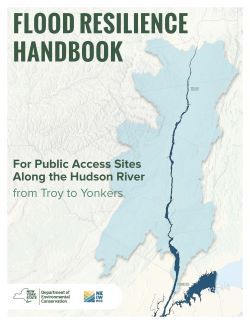MakingWaves - Funding to Repair Dams; Updated CALM; 303(d) Data Solicitation; CWSRF and DWSRF Webinars; Flood Resilience Handbook
The New York State Department of Environmental Conservation sent this bulletin on 05/21/2021 11:00 AM EDT |
| DEC Delivers - Information to keep you connected and informed from the NYS Department of Environmental Conservation |
| Share or view as a web page || Update preferences or unsubscribe |
MakingWaves - News From the Division of Water |
In This Issue:
Reminder: Funding Available to Support High Hazard Dam RepairsUp to $650,000 in grant funding is available to assist eligible dam owners with infrastructure repair costs. Funding is provided through the Federal Emergency Management Agency's (FEMA) High Hazard Potential Dam (HHPD) grant program. DEC is now accepting applications for grants to assist with technical, planning, design, and other pre-construction activities associated with the rehabilitation of eligible dams classified as High Hazard dams. The deadline for applications is June 11, 2021. The Request for Applications is available online through the NYS Grants Gateway. Updated Consolidated Assessment and Listing MethodologyDEC has posted the updated Consolidated Assessment and Listing Methodology (CALM) on its website. The CALM documents the decision-making process for the assessment of water and establishes minimum quality and quantity requirements for water quality monitoring data that are used in assessment. DEC uses the CALM to evaluate the quality of the state’s waters relative to the attainment of DEC water quality standards and a waterbody’s designated best use(s) (i.e., source of water supply, contact recreation, fishing, etc.). Data Solicitation for 2020/2022 CWA Section 303(d) ListAs part of the development of the 2020/2022 New York State Section 303(d) List of Impaired/TMDL Waters, the public is invited to provide water quality data or information. This data solicitation period began May 19, 2021 and will close on September 27, 2021. DEC will then begin compiling a Draft Section 303(d) List, which will be made available for public review and comment in December 2021. States are required to submit their next Section 303(d) Lists to the US Environmental Protection Agency by April 1, 2022. Additional information regarding the Section 303(d) List process can be found in the May 19th Environmental Notice Bulletin and on DEC’s website. CWSRF and DWSRF WebinarsThe NYS Environmental Facilities Corporation (EFC) and the NYS Department of Health (DOH) are hosting two one-hour webinars to present an overview of the Clean Water State Revolving Fund (CWSRF) and Drinking Water State Revolving Fund (DWSRF) programs and provide an opportunity to answer participant questions. The webinars will be held Tuesday, May 25 at 10:00 a.m. and Wednesday, June 16 at 2:00 p.m. The same information will be presented in each webinar. The submission deadline for listing new projects and updates to existing projects for the 2022 Intended Use Plan (IUP) is Friday, July 16, 2021. The webinar will address questions related to the project listing and updating process. Attendance is strongly encouraged. Details and registration information is available on EFC's website. Flood Resilience Handbook for Hudson River Public Access SitesPublic access sites, including parks, preserves, boat launches, and fishing piers along the shores of the tidal Hudson provide recreational, scenic, and economic value to the Hudson Valley. However, climate models project the estuary’s water-levels may rise several feet by the end of this century, threatening the condition and viability of many of these shoreline facilities.
The handbook provides guidelines to begin planning for resilience, including strategies to reduce damage, costs, and other consequences associated with flooding and the effects of climate change. While many aspects of this handbook are relevant to river access sites elsewhere, the geographic focus is on the Hudson River estuary and its tidal tributaries in the 10 counties of the Hudson Valley. The Flood Resilience Handbook was produced by WSP with funding from NEIWPCC in partnership with DEC's Hudson River Estuary Program.
|

 The
The